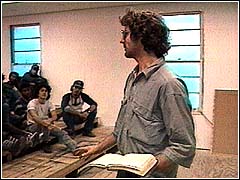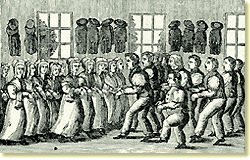| Sects and Cults |
|
|
| As we have seen, classifying a religious movement as a
sect can be both subjective and somewhat imprecise. What some would call
a sect, others might call a denomination. What once had the
characteristics of a sect, society now considers to be denomination.
The problem is even more challenging when one attempts to use a third
classification: the cult. |
|
|
| In the academic study of religion cults can
be defined as "new movements that appear to represent considerable
estrangement from, or indifference to, the older religious traditions;
indeed, many do not at all resemble sectarian secession from an older
tradition." (Livingston, Anatomy of the Sacred, 4th ed, p.
178). The difference between cults and sects
is that
cults represent a more radical break with and rejection of the
teachings and beliefs of established faith traditions. In contrast, sects are more
like offshoots of the major faith tradition. Cults generally arise during times of social turmoil when the established religions
seem to become less relevant and more impersonal. They also appear to meet the
needs of individuals for spiritual freedom and a direct experience of the
sacred. Often cults are an eclectic mix of beliefs, ideas and practices
from a number of different religions. |
There are at least three main characteristics
of a cult:
- A cult is founded by a charismatic leader. Note that the word
"charismatic" in this case means someone with a powerful
personality who naturally attracts people.
- A cult usually claims a new revelation or insight from God that
alters older religious traditions.
- Cults are looked upon by the prevailing society and dominant
religious community with extreme suspicion.
|
| It is this last characteristic of a cult that
creates difficulties in using the term to classify a religious
movement. The academic study of religion uses both the terms cult
and sect as neutral terms. They are not meant to convey a negative judgment
or to reject the teaching of these groups. Remember, the
phenomenological approach requires the scholar to bracket her/his own
convictions in order to understand. Thus, in the academic study of
religion cult and sect are merely descriptive terms. For the dominant culture and
religious groups, however, the word cult often carries a very negative
connotation and is used to indicate groups whose teachings are heretical
if not dangerous.
The second problem in using the term cult is that scholars do not
always agree on whether a group should be classified as a cult or a
sect. In other words, the classification of a movement as either a cult
or a sect is very subjective. For example, notice that The Sacred
Quest suggests that at the time of their origin, the Mormons could be
classified as a cult. In contrast, the writers at the Religious Tolerance
web site classify the original Mormons as a sect! Moreover, both
sources describe how the original movement evolved from a cult or sect
into a denomination! Obviously, there is no widespread agreement on how
or even whether the terms cult and sect should be used. Consequently, many scholars of
religion have abandoned or restricted the use of these terms
and prefer to speak of "new religious
movements." |
Sociologist Bryan Wilson has proposed a new means of classifying new
religious movements. Wilson abandons the term cult altogether, but uses
the term sect to refer to any religious movement of "separated
believers." Thus, for Wilson, cults fall under the category of
sects. According to Wilson, new religious movements can be
understood in terms of how they respond to "the world"
or society. Basically, there are four types of responses. |
| 1. Conversionist groups usually do not
seek to change the world. Rather they strive to transcend the evil
of this world through a conversion experience that is usually highly
emotional and very personal. For example the early 20th century
saw the emergence of Pentecostal groups that emphasized a personal,
emotional spiritual experience, but largely ignored social
reforms. |
| 2. Revolutionist movements believe that salvation
is imminent, but only after the present order is destroyed. In the
United States, a clear example of such a movement is the Branch Davidian
community. Read the entry about the Branch
Davidians at the University of Virginia Religious Movements Web
site. |

David Koresh preaching to Branch Davidians
|
| 3. Gnostic or manipulationist
groups accept and actively pursue what could be described as worldly
goals. The idea is that one can use spiritual techniques to achieve such
goals as long life (or even immortality), wealth, success, health and
power. Scientology with its emphasis on fulfilling one's potential and
freedom from the physical constraints of the material body is an example
of such a group. Read the entry about Scientology
at the University of Virginia Religious Movements Web Site. |
|
|

Shaker Worship Service
|
4. The utopia group seeks not to overthrow the
existing world, but to reconstruct it according to a divinely given
plan. The utopia group always relies upon a communal model for this
reconstruction of the present order. Many such groups arose in American
in the decades before the Civil War. Each sought to create a new,
ideal society purged of evil. One such movement was known as the Shakers. Read the entry about the Shakers
at the UVA Web site. More recently, The People's Temple exemplified a
utopian movement. |
|
|
|

